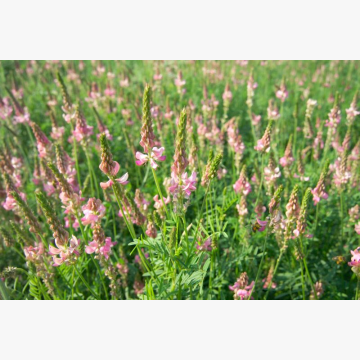Category: Fodder grasses and legumes
FOR CONSULTATIONS APPLY TO:
Commercial director
Lina Smalskienė
tel. +370 618 02 551
e-mail linak@agrolitpa.lt
Sales manager
Tautvydas Kliučininkas
tel. +370 681 35 093
e-mail tautvydask@agrolitpa.lt
Sales manager
Eglė Petkevičienė
tel. +370 626 95 458
e-mail eglep@agrolitpa.lt
Sales manager
Kotryna Nakrošytė
tel.: +370 601 39 282
e-mail kotryna@agrolitpa.lt
Sainfoin
Onobrychis viciifolia Scop.
A nectareous perennial forage plant for fodder
- Fast growth and rapid regrowth
- 2-3 cuts a year
- Average hay yield – 8 t/ha
- DM yield potential – 14 t/ha
- The seed yield from the second cutting can reach 800-1200-1500 kg/ha
- 1000 seeds weight – 20.0-22.0 g
- Good drought tolerance
- Good winterhardiness
- Feed is rich in proteins, vitamins and other valuable nutritional components
- The fodder is of particularly good quality in the second and third years of cultivation
- Typical results of silage analysis: 14 % DM, crude protein – 18 %, digestibility (D-value) – 62, energy value (ME) – 9.5 MJ
- Can be grown alone or mixed with other crops such as alfalfa
- Excellent as a substitute for alfalfa in hilly areas
- Especially recommended as dietary feed in the form of fresh mass for young cattle, especially ruminants
- Unlike red clover, when used even in the early stages of development, even a moist fresh mass, sainfoin does not cause flatulence in ruminants
- Improves the taste of cow's milk and its butter
- Can be used in pig feed as a more digestible component
- Seeds, as a protein-rich component, are often used in horse feed instead of oats
- Medicinal plants because contain phenolic, flavonoid compounds
- For animals, it is a natural anti-helminthic plant
- Nectareous plants, good pre-crop
- Restores soil fertility during cultivation for 2-3 years
- Thanks to a well-developed root system, it perfectly stops soil erosion, can be grown at slopes
- Grows well in calcareous, not necessarily fertile soils, as well as in sandy or gravelly areas
- It also grows on clay soils, but does not tolerate waterlogging
The varietal parameters may differ from those indicated here when the testing circumstances differ from quondam
Recommended sowing rate: 60-80 kg/ha
Recommended sowing rate when growing for green manure: 70-90 kg/ha
UAB „Agrolitpa“
Keravos sreet. 17, Kerava,
LT-38 131 Panevėžys district, LITHUANIA
Enterprise's code 168598128
VAT code LT685981219
Tel. +370 615 11 315
E. mail info@agrolitpa.lt
Keravos sreet. 17, Kerava,
LT-38 131 Panevėžys district, LITHUANIA
Enterprise's code 168598128
VAT code LT685981219
Tel. +370 615 11 315
E. mail info@agrolitpa.lt




.JPG)

